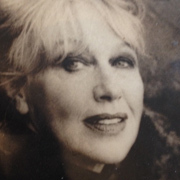
Bridget Armstrong
Bridget Armstrong’s acting CV spans TV, film and theatre in New Zealand and the United Kingdom.
Born in Dunedin in 1937, Armstrong had a Catholic upbringing and attended Otago University. There she first dabbled in acting at the Otago Dramatic Society under the larger than life John V Trevor.
At 18, Armstrong joined national touring company the New Zealand Players, founded by Richard Campion (father of director Jane). Her first show with the company was Salad Days, for which she stepped into the lead role at three hours’ notice. The following day the Waikato Times proclaimed that a new star had been born.
She stayed with the Players for two years, recreating characters from Anne Frank to Elizabeth I. She would also marry another member of the ensemble, Terence Bayler. In the late 50s the couple moved to England to further their acting careers. In 1959 they acted together in a BBC adaptation of Bruce Mason’s The Pohutukawa Tree (Armstrong played Sylvia Atkinson).
In England they had son Michael, and daughter Lucy (who later acted in British soap EastEnders and Nicole Kidman mini-series Bangkok Hilton).
Armstrong embraced the fledgling fringe theatre scene of the 1960s at London venues like The Lamb and Flag, the Royal Court and the Soho, and studied voice under Iris Warren at LAMDA, at a time when many of the students were Americans, aping Marlon Brando. “With every great actor it is always the voice,” said Armstrong later. “Where would Rex Harrison be without his voice? Celia Johnson? Always the voice.”
Armstrong swiftly found success on stage and screen, exercising her comedic and dramatic muscles in TV roles including The Benny Hill Show, Crossroads, and Gloss style soap Compact (for which she designed her own mini-skirts). Later she appeared in Eric Idle's Monty Python followup Rutland Weekend Television, the same year (1975) that a role in a BBC version of play The School for Scandal helped break her out of a line of kooky young blonde roles on screen.
Her first film, with the unlikely title The Amorous Prawn (1962) had been a farce set in a Scottish hotel. Then she got a small role as a makeup artist in Beatles classic A Hard Day’s Night. Armstrong’s favourite screen role is playing Katherine Mansfield in the 1973 BBC production KM & LM: the Claims of Friendship, based on Mansfield’s friendship with Lesley Moore (in NZ the production screened as part of arts show Kaleidoscope). The character of Mansfield hooked her. The same year she appeared in A Picture of Katherine Mansfield, in an episode based on Mansfield’s short story 'The Man Without a Temperament'. Mansfield herself was somewhat improbably played by Vanessa Redgrave.
In 1976 she was “other woman” Marie in box office bomb The Incredible Sarah, directed by Richard Fleischer (Fantastic Voyage). Glenda Jackson was Oscar-nominated for her performance as legendary French actor Sarah Bernhardt.
Armstrong’s longest role on the West End was a 14-month spell at the Queen’s Theatre in Peter Ustinov comedy Halfway Up the Tree, in which she played a 16-year-old Norwegian au pair at the age of 35. Directing the play was John Gielgud, at the time struggling to get laughs for his own performance in Moliere’s Tartuffe. He worked Armstrong hard and gave her the (possibly envious) backhanded compliment: “It’s a disgrace what you're doing. You're leading the audience on to excessive, unreal laughter. You're a very clever child but you're full of the most appalling cheap tricks, and you must never, ever, think that you're funny.”
In 1978 Armstrong divorced Terence Bayler and married author Maurice Shadbolt. The pair returned to New Zealand, and she acted on stage in Private Lives and Ashes. Armstrong was also part of the dinner party ensemble in a well-reviewed 1979 movie of Roger Hall’s Middle Age Spread. She would act alongside Shadbolt in a German-directed film of his novel Among the Cinders (playing the German mother of the teen protagonist). She also co-starred in kidult series Gather Your Dreams, playing one of a party of travelling performers during the depression, and cameoed in offbeat drama series Seekers and big screen classic Came a Hot Friday.
Armstrong’s biggest Kiwi screen role to date is 1983 odd couple comedy An Age Apart. The series saw her playing a solo mother who invites her 60-something brother (British comedy actor Deryck Guyler) to live with her and her son in New Zealand.
Now in her 60s, the screen offers continued: in the 1990s she featured in Desperate Remedies, a TV adaptation of play Joyful and Triumphant and a 1997 episode of England’s long-running Ruth Rendell Mysteries.
By now Armstrong had relocated to the UK once more, where she became a milliner and opened a salon in Wimbledon. Her signature Bridget Armstrong hat is inspired by the famous brown felt Bloomsbury number worn by Virginia Woolf, which Armstrong first wore while acting in A Picture of Katherine Mansfield.
Profile written by Julie Hill
Sources include
Bridget Armstrong
Bridget Armstrong Hats website. Accessed 17 November 2015
Brian McNeill, ‘Bridget Armstrong’(Interview) -Art New Zealand number 12, Winter 1979
NZPA, ‘Obituary: Maurice Shadbolt’ - The NZ Herald, 12 October 2004
‘Bridget Armstrong’ Internet Movie Database website. Accessed 17 November 2015